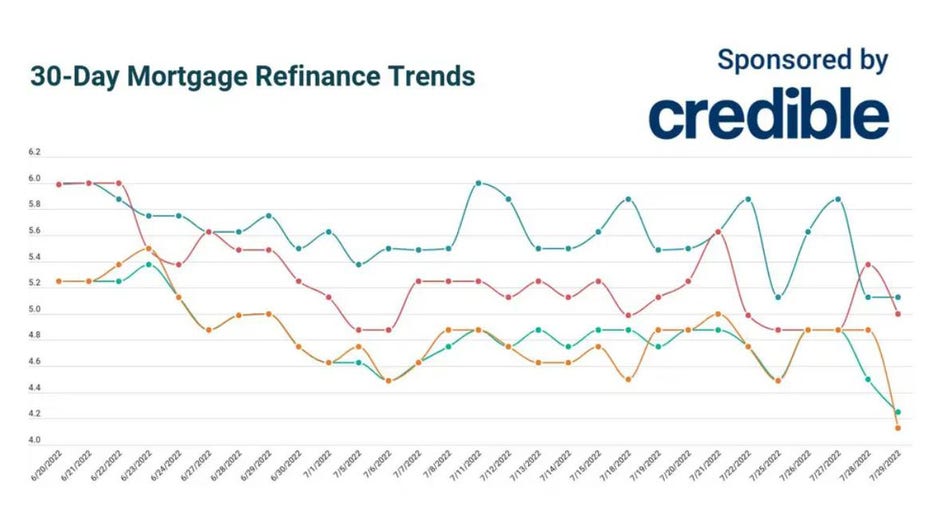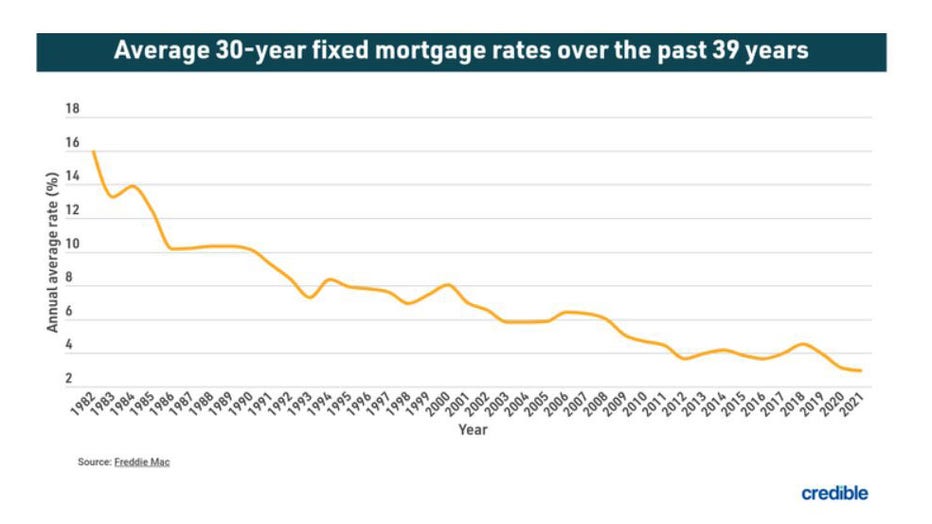Savings window open: 3 key mortgage refinance rates tumble | July 29, 2022
Our goal here at Credible Operations, Inc., NMLS Number 1681276, referred to as "Credible" below, is to give you the tools and confidence you need to improve your finances. Although we do promote products from our partner lenders, all opinions are our own.

Check out the mortgage refinancing rates for July 29, 2022, which are largely down from yesterday. (Credible)
Based on data compiled by Credible, three key mortgage refinance rates have fallen and one remained unchanged since yesterday.
- 30-year fixed-rate refinance: 5.125%, unchanged
- 20-year fixed-rate refinance: 5.000%, down from 5.375%, -0.375
- 15-year fixed-rate refinance: 4.250%, down from 4.500%, -0.250
- 10-year fixed-rate refinance: 4.125%, down from 4.875%, -0.750
Rates last updated on July 29, 2022. These rates are based on the assumptions shown here.
If you’re thinking of doing a cash-out refinance or refinancing your home mortgage to lower your interest rate, consider using Credible. Credible's free online tool will let you compare rates from multiple mortgage lenders. You can see prequalified rates in as little as three minutes.
What this means: Three key mortgage refinance rates fell significantly today, while 30-year rates held steady. Rates for 10- and 15-year terms fell to their lowest levels since the beginning of June, offering substantial money-saving opportunities for homeowners who lock in a rate for one of these shorter terms. Rates for 20- and 30-year terms are still sitting at or above 5%, so homeowners looking to refinance may find the better bargain with shorter terms. Shorter repayment terms do come with higher monthly payments, but they allow homeowners to be mortgage-free sooner.
WHAT IS CASH-OUT REFINANCING AND HOW DOES IT WORK?
How mortgage rates have changed over time
Today’s mortgage interest rates are well below the highest annual average rate recorded by Freddie Mac — 16.63% in 1981. A year before the COVID-19 pandemic upended economies across the world, the average interest rate for a 30-year fixed-rate mortgage for 2019 was 3.94%. The average rate for 2021 was 2.96%, the lowest annual average in 30 years.
The historic drop in interest rates means homeowners who have mortgages from 2019 and older could potentially realize significant interest savings by refinancing with one of today’s lower interest rates.

If you’re ready to take advantage of current mortgage refinance rates that are below average historical lows, you can use Credible to check rates from multiple lenders.
How to get your lowest mortgage refinance rate
If you’re interested in refinancing your mortgage, improving your credit score and paying down any other debt could secure you a lower rate. It’s also a good idea to compare rates from different lenders if you're hoping to refinance so you can find the best rate for your situation.
Borrowers can save $1,500 on average over the life of their loan by shopping for just one additional rate quote, and an average of $3,000 by comparing five rate quotes, according to research from Freddie Mac.
Be sure to shop around and compare current mortgage rates from multiple mortgage lenders if you decide to refinance your mortgage. You can do this easily with Credible's free online tool and see your prequalified rates in only three minutes.
How does Credible calculate refinance rates?
Changing economic conditions, central bank policy decisions, investor sentiment and other factors influence the movement of mortgage refinance rates. Credible average mortgage refinance rates reported in this article are calculated based on information provided by partner lenders who pay compensation to Credible.
The rates assume a borrower has a 740 credit score and is borrowing a conventional loan for a single-family home that will be their primary residence. The rates also assume no (or very low) discount points and a down payment of 20%.
Credible mortgage refinance rates reported here will only give you an idea of current average rates. The rate you receive can vary based on a number of factors.
Think it might be the right time to refinance? Be sure to shop around and compare rates with multiple mortgage lenders. You can do this easily with Credible and see your prequalified rates in only three minutes.
Are there any cons to refinancing?
Refinancing a mortgage can be a good way to lower interest costs over the life of a loan, shorten your repayment term or secure a lower interest rate. But refinancing has some potential pitfalls, too.
It’s possible for refinancing to actually cost you more money than you’ll save if:
- You refinance into a repayment term that’s longer than your original mortgage. Longer repayment terms usually mean lower monthly payments — but higher interest rates and greater interest costs over the life of a loan. To reap the most savings from a refinance, try refinancing into a shorter term than you have for your current mortgage.
- You sell your home before you reach the break-even point on your new loan. Like your original mortgage, your refinance will come with closing costs. And it will take some time before your savings add up to as much as your closing costs.
That said, the con you need to consider first is closing costs. You’ll need to fund these from your own pocket or roll them into the loan (which raises its lifetime costs). Closing costs typically run 3% to 5% — or more — of the amount you’re borrowing. So if you want to refinance your $200,000 loan to get a lower interest rate, you’ll pay an estimated $6,000 to $10,000 in closing costs.
Have a finance-related question, but don't know who to ask? Email The Credible Money Expert at moneyexpert@credible.com and your question might be answered by Credible in our Money Expert column.
As a Credible authority on mortgages and personal finance, Chris Jennings has covered topics that include mortgage loans, mortgage refinancing, and more. He’s been an editor and editorial assistant in the online personal finance space for four years. His work has been featured by MSN, AOL, Yahoo Finance, and more.

